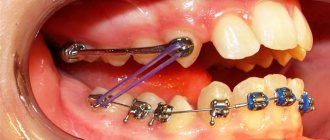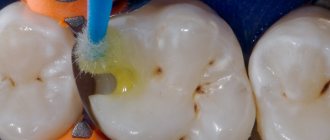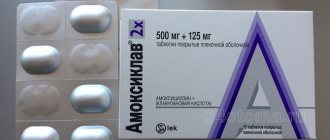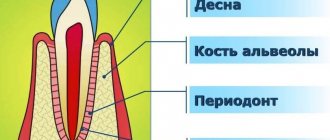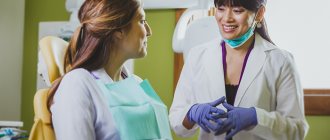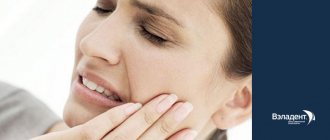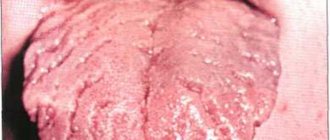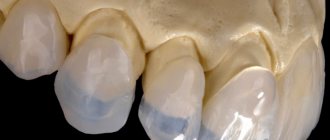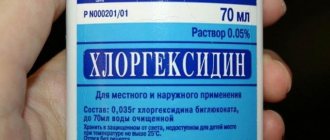Nosological classification (ICD-10)
- M65.4 Tenosynovitis of the styloid process of the radius [de Quervain's syndrome]
- M71 Other bursopathies
- M77.0 Medial epicondylitis
- M77.1 Lateral epicondylitis
- M77.9 Enthesopathy, unspecified
- R60.0 Localized edema
- T14.3 Dislocation, sprain and damage to the capsular-ligamentous apparatus of a joint of an unspecified area of the body
- T14.9 Injury, unspecified
- T88.9 Complication of surgical and therapeutic intervention, unspecified
Compound
| Homeopathic drops for oral administration | 1 fl. |
| 100 g required for preparation | |
| active substances: | |
| Arnica montana (Arnica) (arnica montana (arnica) D2 | 5 g |
| Calendula officinalis (Calendula) (calendula officinalis (calendula) D2 | 5 g |
| Hamamelis virginiana (Hamamelis) (witch hazel) D2 | 5 g |
| Achillea millefolium (Millefolium) (Achillea millefolium (millefolium) D3 | 5 g |
| Atropa bella-donna (Belladonna) (atropa bella-donna (belladonna) D4 | 25 g |
| Aconitum napellus (Aconitum) D3 | 10 g |
| Mercurius solubilis Hahnemanni (Mercurius solubilis Hahnemanni) D8 | 10 g |
| Hepar sulfuris (Hepar sulfuris calcareum) (Hepar sulfuris (Hepar sulfuris calcareum) D8 | 10 g |
| Chamomilla recutita (Chamomilla) (Chamomilla recutita (Chamomilla) D3 | 8 g |
| Symphytum officinale (Symphytum) (symphytum officinale (symphytum) D8 | 8 g |
| Bellis perennis (Bellis perennis) D2 | 2 g |
| Echinacea (echinacea) D2 | 2 g |
| Echinacea purpurea (Echinacea purpurea) D2 | 2 g |
| Hypericum perforatum (Hypericum) (hypericum perforatum (hypericum) D2 | 1 g |
| ethanol | about 35 vol.% |
| Ointment for external use, homeopathic | 1 tube |
| 100 g required for preparation | |
| active substances: | |
| Arnica montana (Arnica) (arnica montana (arnica) D3 | 1.5 g |
| Calendula officinalis (Calendula) (calendula officinalis (calendula) × | 0.45 g |
| Hamamelis virginiana (Hamamelis) (hamamelis virginiana (witch hazel) × | 0.45 g |
| Echinacea (echinacea) × | 0.15 g |
| Echinacea purpurea (Echinacea purpurea) × | 0.15 g |
| Chamomilla recutita (Chamomilla) (Chamomilla recutita (Chamomilla) × | 0.15 g |
| Symphytum officinale (Symphytum) (symphytum officinale (symphytum) D4 | 0.1 g |
| Bellis perennis | 0.1 g |
| Hypericum perforatum (Hypericum) (hypericum perforatum (hypericum) D6 | 0.09 g |
| Achillea millefolium (Millefolium) (Achillea millefolium (millefolium) × | 0.09 g |
| Atropa bella-donna (Belladonna) (atropa bella-donna (belladonna) D1 | 0.05 g |
| Aconitum napellus (Aconitum) D1 | 0.05 g |
| Mercurius solubilis Hahnemanni (Mercurius solubilis Hahnemanni) D6 | 0.04 g |
| Hepar sulfuris (Hepar sulfuris calcareum) (Hepar sulfuris (Hepar sulfuris calcareum) D6 | 0.025 g |
| excipients: hydrophilic base stabilized with 13.8% (by volume) ethanol | |
| composition of the hydrophilic base: emulsifying cetyl stearyl alcohol - 8.007 g; liquid paraffin - 9.342 g, white petroleum jelly - 9.342 g; water - 60.579 g; ethanol 96% (by volume) - 9.335 g |
| Homeopathic solution for intramuscular and periarticular administration | 1 amp. (2.2 ml) |
| active substances: | |
| Arnica montana (Arnica) (arnica montana (arnica) D2 | 2.2 µl |
| Calendula officinalis (Calendula) (calendula officinalis (calendula) D2 | 2.2 µl |
| Hamamelis virginiana (Hamamelis) (witch hazel) D1 | 0.22 µl |
| Achillea millefolium (Millefolium) (Achillea millefolium (millefolium) D3 | 2.2 µl |
| Atropa bella-donna (Belladonna) (atropa bella-donna (belladonna) D2 | 2.2 µl |
| Aconitum napellus (Aconitum) (aconitum napellus (aconitum) D2 | 1.32 µl |
| Mercurius solubilis Hahnemanni (Mercurius solubilis Hahnemanni) D6 | 1.1 µl |
| Hepar sulfuris (Hepar sulfuris calcareum) (Hepar sulfuris (Hepar sulfuris calcareum) D6 | 2.2 µl |
| Chamomilla recutita (Chamomilla) (Chamomilla recutita (Chamomilla) D3 | 2.2 µl |
| Symphytum officinale (Symphytum) (symphytum officinale (symphytum) D6 | 2.2 µl |
| Bellis perennis (Bellis perennis) D2 | 1.1 µl |
| Echinacea (echinacea) D2 | 0.55 µl |
| Echinacea purpurea (Echinacea purpurea) D2 | 0.55 µl |
| Hypericum perforatum (Hypericum) (hypericum perforatum (hypericum) D2 | 0.66 µl |
| excipients: sodium chloride to establish isotonia - about 9 mg/ml; water for injection - up to 2.2 ml |
| Homeopathic lozenges | 1 table |
| active substances: | |
| Arnica montana (Arnica) (arnica montana (arnica) D2 | 15 mg |
| Calendula officinalis (Calendula) (calendula officinalis (calendula) D2 | 15 mg |
| Hamamelis virginiana (Hamamelis) (witch hazel) D2 | 15 mg |
| Achillea millefolium (Millefolium) (Achillea millefolium (millefolium) D3 | 15 mg |
| Atropa bella-donna (Belladonna) (atropa bella-donna (belladonna) D4 | 75 mg |
| Aconitum napellus (Aconitum) D3 | 30 mg |
| Mercurius solubilis Hahnemanni (Mercurius solubilis Hahnemanni) D8 | 30 mg |
| Hepar sulfuris (Hepar sulfuris calcareum) (Hepar sulfuris (Hepar sulfuris calcareum) D8 | 30 mg |
| Chamomilla recutita (Chamomilla) (Chamomilla recutita (Chamomilla) D3 | 24 mg |
| Symphytum officinale (Symphytum) (symphytum officinale (symphytum) D8 | 24 mg |
| Bellis perennis (Bellis perennis) D2 | 6 mg |
| Echinacea (echinacea) D2 | 6 mg |
| Echinacea purpurea (Echinacea purpurea) D2 | 6 mg |
| Hypericum perforatum (Hypericum) (hypericum perforatum (hypericum) D2 | 3 mg |
| excipients: magnesium stearate - 1.5 mg; lactose - to obtain a tablet weighing 0.302 g |
Composition and principle of action
Traumeel is a homeopathic drug that has an anti-inflammatory, analgesic, and hemostatic effect. Using the product allows you to maintain veins in good shape. When active substances enter the body, the functions of regeneration and immune defense of the body are activated.
The indicated characteristics and properties of the drug are due to the presence of the following active components:
- Calendula. It has a general strengthening effect, helps stabilize metabolic functions in the body, accelerates blood circulation processes, soothes inflamed and irritated areas, removes toxic substances from the body, starts the processes of regeneration and restoration of damaged cells;
- Witch hazel. It has a general antibacterial effect, prevents the occurrence of swollen areas, stabilizes the functioning of steel glands, and has a tonic effect on blood vessels;
- Echinacea. Improves the body's immune functions, increases the protective functions of organs;
- Chamomile. Improves the processes of restoration of damaged tissues, relieves irritation and redness of the skin, moisturizes flaky areas, promotes rapid healing of burns;
- Daisy. Protects damaged areas from the penetration of microbes and bacteria, removes waste and toxins from the body;
- Millennium. Promotes rapid healing of wounds, prevents infection by microbes and bacteria, reduces pain, and prevents the development of inflammation;
- Arnica. Relieves pain, increases the rate of wound healing by relieving inflammation and improving blood circulation in the body;
- Belladonna. Has an analgesic effect on the body;
- St. John's wort. Stabilizes metabolic processes in the body, stops bleeding, disinfects the affected area of the skin;
- Mercurius solubilis Hahnemanni – prevents the development of inflammatory processes, relieves pain in joints and bones, alleviates rheumatism;
- Hepar sulfuris – relieves swelling and inflammation, resolves hemorrhages, helps remove pus from wounds.
Description of the dosage form
Homeopathic drops for oral administration: transparent, colorless or light yellow liquid with the odor of ethanol.
Ointment for external use, homeopathic: white to yellowish or pinkish-white in color, with a weak characteristic odor; There should be no rancid odor.
Homeopathic solution for intramuscular and periarticular administration: colorless, transparent, odorless liquid.
Homeopathic lozenges: round, flat-cylindrical in shape, chamfered, white or yellowish-white, sometimes with yellow, orange or gray inclusions. There is practically no smell.
Contraindications
For all dosage forms
increased individual sensitivity to the components of the drug (known increased sensitivity to yarrow, chamomile, marigold, perennial daisy, echinacea, mountain arnica or other plants of the Asteraceae family);
tuberculosis;
leukemia;
collagenosis;
multiple sclerosis;
autoimmune diseases, including AIDS, HIV infection;
children under 12 years of age (due to insufficient clinical data) - for lozenges, solution for intramuscular and periarticular administration and drops for oral administration.
children under 3 years of age (due to insufficient clinical data) - for homeopathic ointment for external use.
Additionally for homeopathic lozenges
lactase deficiency, lactose intolerance, glucose-galactose malabsorption.
Additionally for homeopathic drops for oral administration
With caution: liver disease, alcoholism, traumatic brain injury and brain diseases.
Injection with Traumeel
One of the most common and pressing problems in dentistry is the treatment of periodontal diseases. By periodontium we mean not only the gum itself, but also the periodontium, as well as the alveolar processes. When an infection enters one of these zones, an inflammatory process begins in it, characterized by the following symptoms:
- an increase in the volume of tartar, especially on the inside of the tooth;
- destruction of the tissues connecting the tooth to the gum, as a result of which it begins to wobble and “fall in” when biting, mobility appears;
- the appearance of pathological periodontal pockets;
- periodontal disease - thinning of the bone substance of the jaw;
- exposure of tooth roots;
- bleeding in the gum area;
- bad breath.
If you experience at least some of the listed symptoms, it’s time to make an appointment with a dentist, who will conduct an examination, determine the degree of advanced disease and prescribe adequate treatment.
How and with what are periodontal diseases treated?
Until recently, the only effective treatment was the prescription of antibiotic drugs. Yes, they successfully cope with the existing infection, but such therapy can hardly be called a panacea for periodontal diseases.
Firstly, after some time, resistance almost inevitably arises, that is, addiction to a particular drug. It stops working and the dentist has to look for a replacement and adjust the treatment regimen. Secondly, taking antibiotics, even topically, is often fraught with side effects. The most common manifestations of this effect are:
- dysbacteriosis, gastritis and colitis;
- peptic ulcer;
- disorders of the liver and kidneys;
- allergic reactions;
- candidiasis;
- general decrease in immunity.
That is why today a worthy alternative to antibiotics has been found in dentistry - the homeopathic drug Traumeel. It contains plant components such as chamomile, arnica, echinacea, calendula, yarrow, St. John's wort and some others. Thanks to the plant-mineral composition, taking Traumeel is not accompanied by side effects, and the drug acts on the source of infection in the periodontium gently and effectively.
Dental clinic "Dent Prestige": treatment of periodontal diseases using progressive methods
Doctors at our clinic actively practice the treatment of pathological processes developing in the periodontal area using injections of the drug “Traumel”. Why is it better to do this in the dentist's office rather than some other method?
Due to their own busyness, lack of time and reluctance to visit medical institutions, some patients are ready to self-medicate. However, in dentistry this approach is impossible - giving an injection into the gum area is much more difficult than a conventional intramuscular one. Only a specialist knows how to do this correctly, safely, painlessly and effectively. In addition, during the treatment process, the dentist will be able to observe the body's response to treatment, noting progress or lack thereof.
Therefore, we invite everyone who has noticed the first signs of pathology in the periodontium to visit our clinic, carry out a comprehensive examination and examination, if necessary, get a prescription for injections with Traumeel and complete the entire prescribed course of treatment, with which our competent and experienced dentists. The cost of the procedure is quite affordable even for patients with low incomes, and the painlessness and effectiveness of treatment is guaranteed by the professionalism of the staff of the Dent Prestige clinic.
Drug Traumeel S
The drug belongs to the drugs that are prescribed primarily when choosing drugs for the treatment of damaged soft tissues (burns, injuries, surgeries, etc.). Traumeel is a homeopathic medicine that contains:
- aconite (has an anti-inflammatory effect and increases vascular tone);
- arnica montana (promotes tissue regeneration and resolves hematomas);
- belladonna (has anti-inflammatory and analgesic effects);
- witch hazel virginiana (has the same properties as belladonna);
- St. John's wort (used as an antiseptic, anti-inflammatory and tonic);
- daisy officinalis (has antifever, analgesic effect, regulates general metabolism);
- chamomile (has antiallergic and analgesic effects, enhances wound healing);
- comfrey (promotes bone tissue restoration);
- common yarrow (used as a hemostatic agent for external and internal bleeding);
- Echinacea purpurea (has an anti-inflammatory effect and stimulates the immune system);
- calendula (has an analgesic effect and promotes the formation of granulation tissue);
- mercury (mercury);
- liver is sulfuric.
Side effects
For homeopathic lozenges, homeopathic solution for intramuscular and periarticular administration and homeopathic drops for oral administration
Allergic reactions are possible. In rare cases, increased salivation may occur after taking the drug. If side effects develop, you should stop taking the drug and consult your doctor.
For ointment for external use homeopathic
When using the ointment, in some cases hypersensitivity reactions (allergic skin reactions) may occur. If side effects are detected, incl. not described in the instructions, you should stop taking the drug and consult your doctor.
Additionally for a solution for intramuscular and periarticular administration, homeopathic. Very rarely - the appearance of redness, swelling, itching at the injection site.
Directions for use and doses
Homeopathic drops for oral administration. Orally, 15 minutes before meals, 10 drops (pre-diluted in 1 teaspoon of water and kept in the mouth for 1-2 minutes before swallowing) 3 times a day, for swelling of soft tissues - 30 drops 3 times a day. Course of treatment: for post-traumatic conditions - 2 weeks or more; for inflammatory diseases - at least 3-4 weeks.
Homeopathic ointment for external use. Locally, unless otherwise prescribed, for children over 3 years of age and adults, a sufficient amount of ointment is applied in a thin layer to the skin of painful areas of the body and rubbed in with light movements 2-3 times a day. It is possible to apply an ointment bandage. The course of treatment for post-traumatic conditions is 2 weeks or more; for inflammatory diseases - at least 3-4 weeks.
Homeopathic solution for intramuscular and periarticular administration. IM, periarticular: 1–2 amp. 1–3 times a week. The course of treatment is 4–5 weeks. The frequency of use and duration of the course are prescribed by the doctor.
Note: it is recommended to take several dosage forms of the drug simultaneously (for example, tablets or drops along with ointment and injections).
Opening the ampoule. The colored dot should be at the top. The contents in the ampoule head should be shaken off by lightly tapping. After this, break off the upper part of the ampoule by pressing at the colored point.
Homeopathic lozenges. Usually dissolve 1 tablet in the mouth. 3 times a day 15 minutes before meals, keep the tablet in the mouth until completely absorbed. Course of treatment: for dislocations and sprains - 2 weeks or more; for inflammatory diseases - at least 3-4 weeks. Use of the drug for more than 8 weeks is possible after consultation with a doctor.
Application in dentistry
The homeopathic drug Traumeel is used in dentistry in the following cases:
- To relieve pain;
- Prevention of inflammatory processes in damaged areas;
- Stimulating tissues for the process of restoration and regeneration;
- Strengthening the body's immune characteristics to resist the disease;
- Improving vascular tone in the area of damaged tissue;
- Prevention of hemorrhage;
- Improving blood circulation in the damaged area.
The drug is also prescribed by a dentist in case of treatment with antibiotics for a speedy recovery of the body.
Indications for use of Traumeel S in dentistry:
- Periodontal disease;
- Various dislocations in the temporomandibular region;
- Jaw fracture;
- Eruption of permanent teeth in childhood and wisdom teeth in adulthood;
- Injury to the oral cavity;
- Development of inflammatory diseases in the oral cavity;
- Carrying out surgical operations in the oral cavity;
- Gingivitis;
- Purulent diseases in the oral cavity;
- Other dental problems;
- Preventive injections for gums.
special instructions
For all dosage forms
When taking homeopathic medicines, existing symptoms may temporarily worsen (primary deterioration). In this case, you should stop taking the drug and consult your doctor. If side effects occur that are not described in the instructions for medical use, you should inform your doctor or pharmacist.
To increase the effectiveness of treatment, it is recommended to take various dosage forms of the drug, for example ointments and drops or tablets and injection solution.
Impact on the ability to drive vehicles and operate machinery. Does not affect.
For homeopathic drops for oral administration
The maximum single dose of the drug (30 drops) contains about 0.49 g of absolute ethyl alcohol (ethanol), the maximum daily dose of the drug (90 drops) contains about 1.47 g of absolute ethyl alcohol (ethanol).
The drug in the form of drops and ointments must be protected from overheating.
The bottle and tube should be closed immediately after taking the drug.
Additionally for homeopathic lozenges
Information for patients with diabetes: carbohydrate content in 1 table. of the drug corresponds to 0.025 XE.
Must be protected from moisture.
Close the pencil case immediately after using the drug.
How can you replace Traumeel?
During teething, you can use Kalgel, Dentokind, Dentinox, Baby Doctor instead of Traumeel.
For adults: Parodontocide, Cholisal, Metrogyl Denta, Asepta, Chlorhexidine, Troxevasin, Mundizal, Tsiprolet, Dental drops, Denta-drops.
Any analogue should be approved by the attending physician, and not on the advice of a pharmacist.
Release form
Homeopathic drops for oral administration. 30 ml in a dark glass bottle of hydrolytic class III with a built-in PE dropper and a tamper evident screw cap made of polypropylene. Each bottle is placed in a cardboard pack.
Homeopathic ointment for external use. 50 or 100 g in an aluminum tube with a screw cap made of propylene. Each tube is placed in a cardboard pack.
Homeopathic solution for intramuscular and periarticular administration. 2.2 ml in ampoules of colorless glass of hydrolytic class I. Each ampoule is marked with a notch and a colored dot. 5 amp. placed in an open plastic blister pack. 1 or 20 open plastic blister packs (with 5 or 100 amps) are placed in a cardboard pack.
Homeopathic lozenges. 50 tablets each in white polypropylene cases with polypropylene lids. A label is glued to each pencil case and placed in a cardboard box.
